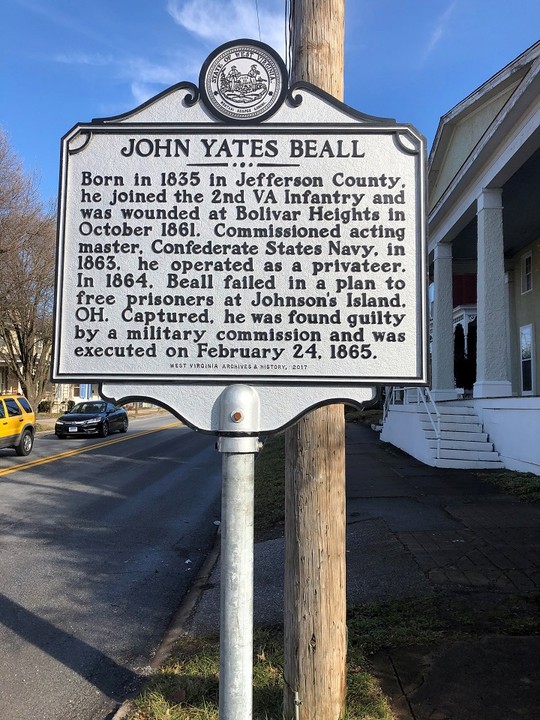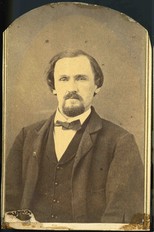John Yates Beall Highway Historical Marker
Introduction
Text-to-speech Audio
Images
John Yates Beall Highway Historical Marker

John Yates Beall (1835-1865)

Backstory and Context
Text-to-speech Audio
John Yates Beall was born on his family’s farm on January 1, 1835 near Charles Town, Virginia (now West Virginia). In 1852, he enrolled at the University of Virginia in Charlottesville. Three years later, in June 1855, Beall dropped out before earning a degree. After his father’s death later that same year, he took over management of the family farm.
Following John Brown’s raid on the federal arsenal at Harper’s Ferry, Beall enlisted as a private in the Charles Town militia company—known as the Botts Greys—and was on duty during Brown’s trial and execution in Charles Town in late 1859. Following the bombardment of Fort Sumter and President Lincoln’s call for 75,000 volunteers to suppress the rebellion in the southern slave states, the Botts Greys became Company G of the Second Virginia Infantry. The company would eventually become part of Confederate General Thomas Jackson’s famous “Stonewall Brigade.” In the fall of 1861, while detailed in Jefferson County, Beall learned of the fighting at nearby Bolivar Heights. He joined Lieutenant Colonel Ashby’s Confederate troops and sustained a gruesome chest wound while leading a charge.
In the spring of 1862, after a lengthy recovery from his battle wound, Beall rejoined Jackson’s brigade in Jefferson County. During the confusion of a retreat in the Shenandoah Valley, he became separated from his unit. Frustrated and unable to find it, Beall set out for Iowa, where his older brother set him up with a job operating a gristmill. That fall, fearing that his identity as a Confederate soldier was about to be revealed, he left Iowa for Canada, eventually settling near Toronto. In January 1863, Beall left Canada for Richmond.
While residing in the Confederate capital, he pitched a plan to Confederate President Jefferson Davis. Eager to get back in the fight, Beall proposed leading guerrilla naval operations against federal targets in the Chesapeake Bay. President Davis approved the plan and commissioned him an acting master in the Confederate navy. Over the course of several months, Beall and his men, operating from a secret headquarters in Mathews County and equipped with a yawl and a sailing canoe, captured U.S. merchant ships, destroyed a lighthouse, and severed underwater telegraph cables. In the fall of 1863, federal troops captured Beall and his men. After months in federal captivity, Beall gained his freedom as part of a prisoner exchange in March 1864.
In August of that same year, he traveled to Canada, where he contacted Lieutenant Colonel Jacob Thompson, who oversaw Confederate operations along the U.S.-Canada border. Thompson ordered Beall to conduct a raid to free Confederate prisoner of war held on Johnson’s Island on Lake Erie. The raid, however, was called off during its early stages. Soon after, Beall joined a small group of Confederate saboteurs who were tasked with derailing federal trains transporting Confederate prisoners of war. In December, federal troops captured him at Niagara Falls. Federal authorities eventually transported Beall to Fort Lafayette to stand trial for spying, attempting to derail federal trains, and for his role in the failed raid on Johnson’s Island. After being convicted, Beall was sent to Fort Columbus on Governors Island in New York Harbor. There, on February 24, 1865, he was executed. His body was buried in Green-Wood Cemetery in Brooklyn. In 1870, relatives reinterred his remains in the Zion Episcopal Church Cemetery in Charles Town.
In 2017, as part of its Civil War sesquicentennial project, the West Virginia Highway Historical Marker Program of the West Virginia Archives and History installed a marker dedicated to John Yates Beall. It stands near the intersection of East Washington and North Mildred Streets in Charles Town, Jefferson County.
Sources
Moseley, Cameron S. and the Dictionary of Virginia Biography. "John Y. Beall (1835-1865)." Encyclopedia Virginia. Virginia Humanities. 10 July 2013. Web. 22 September 2020 <https://www.encyclopediavirginia.org/beall_john_y_1835-1865>.
http://www.wvculture.org/history/markers/sesqui/johnyatesbeall.html
https://www.encyclopediavirginia.org/beall_john_y_1835-1865
